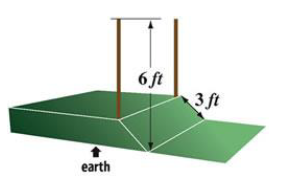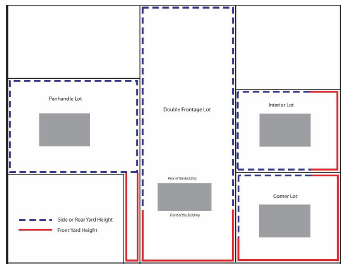(a) Permit required.
(1) No person shall construct or erect a fence or wall without first obtaining an approved certificate of zoning compliance and/or a building permit, if applicable. Permits are not required for repairs of existing fences, for replacement of a fence for which the original permit can be produced, or for invisible fences.
(2) A certificate of zoning compliance shall not be required for vegetative hedges or invisible fences but they shall be subject to any applicable requirements of this section.
(3) No person shall construct or erect a fence or wall on a vacant lot unless established as a temporary construction fence.
(b) General requirements.
(1) All fences, walls, and hedges shall be subject to the intersection visibility requirements of § 1208.05.
(2) Fences shall be subject to the standards of Chapter 1438 of the Middletown Code of Ordinances in addition to this section.
(3) All fences, walls, hedges and invisible fences, and any related supporting structures or appurtenances, shall be contained within the lot lines of the applicable lot and shall not encroach into adjoining or abutting lots and/or rights-of-way.
(4) The smooth finished side of the fence or wall shall be the side of the fence that faces outward from the lot or yard being fenced. If a fence has two similarly finished sides, either side may face the adjacent property.
(5) All fences, walls, and hedges shall be maintained in a neat and orderly manner.
(6) Walls shall be prohibited within all utility easements. Fences that are placed in utility easements are subject to removal without notice by utility companies or the City when work is being done in the utility easements. Replacement of the fence shall be at the property owner's expense.
(7) Fences, walls, and hedges shall not impede, inhibit, or obstruct culverts, drains, natural watercourses, or storm water drainage in any zoning district.
(8) It shall be the duty of each lot owner and contractor, or an agent thereof, to determine lot lines and to ascertain that the fence or wall does not deviate from the plans as approved by the Development Code Administrator issuing the certificate of zoning compliance, and that the fence does not encroach on another lot or existing easement. The issuance of the certificate and any inspection by the City shall not be construed to mean that the City has determined the fence is not encroaching on another lot, nor shall it relieve the property owner of the duty imposed on him or her herein.
(c) Measurement.
(1) The maximum fence or wall height shall be measured from the lowest point within three feet on either side of the fence to the top most portion of the fence between posts. See Figure 1208-C. The structure posts may exceed the maximum height allowed in this section by up to six inches including any decorative features.

(2) A fence may be erected on top of a wall but the combined height of the fence and wall shall not exceed the heights specified within this section for a fence or wall. Fences or walls located on top of a retaining wall shall be measured from the top of the finished grade at the top of the retaining wall.
(d) Materials.
(1) In the UC District, the fence or wall materials and style must conform to the historic character of the district. Fences shall only consist of wood, ornamental iron or aluminum, or vinyl material which resembles wood, ornamental iron or aluminum. Walls shall only be constructed with brick or stone exposed surfaces or traditional stucco (synthetic stucco such as EIFS is prohibited). Chain link, wire, and barbed wire fences are expressly prohibited all UC Subdistricts.
(2) Chain link fencing shall not be used around the perimeter of the lot.
(3) All fences shall be constructed of commonly accepted fence material types include wood, aluminum, vinyl, metal, etc., as determined by the Development Code Administrator. The use of salvaged materials, metal that is typically used for building siding, or other materials shall be prohibited.
(e) Fences, walls, and hedges in front yards. The following shall apply to fencing, walls, and hedges in front yards (see Figure 1208-D):
(1) Fences, walls, and hedges shall not exceed 48 inches in the front yard or along any lot line that is adjacent to a street, including corner lots, in any residential district or in the O-1 or O-2 Districts.
(2) Fences and walls shall not exceed six feet in any front yard of any other zoning district except where such fence meets the minimum setback requirements for buildings in the applicable district.
(3) For double frontage lots, fencing in the rear yard may exceed 48 inches if the fencing is set back a minimum of 50 feet from the right-of-way but in no case shall it exceed the height allowed in rear yards for the applicable zoning district. This setback shall not apply if the entire block face contains double frontage lots with the rear façade of the buildings facing the same street.
(f) Fences, walls, and hedges in side and rear yards. The following shall apply to fencing, walls, and hedges in side and rear yards (see Figure 1208-D):
(1) There shall not be a height requirement for hedges in side and rear yards.
(2) Fences and walls shall not exceed six feet in height in any side or rear yard within any residential district or in the O-1 and O-2 Districts.
(3) Fences and walls shall not exceed ten feet in height in any side or rear yard within any residential district or in the I-1 and I-2 Districts.
(4) Fences and walls shall not exceed eight feet in any side or rear yard of any other zoning district.

(g) Temporary fences. Fences around construction sites shall be allowed for the duration of the construction work. A certificate of zoning compliance shall not be required for temporary fences.
(Ord. O2018-02, passed 2-20-2018; Am. Ord. O2018-44, passed 8-7-2018; Am. Ord. O2020-47, passed 10-6-2020)